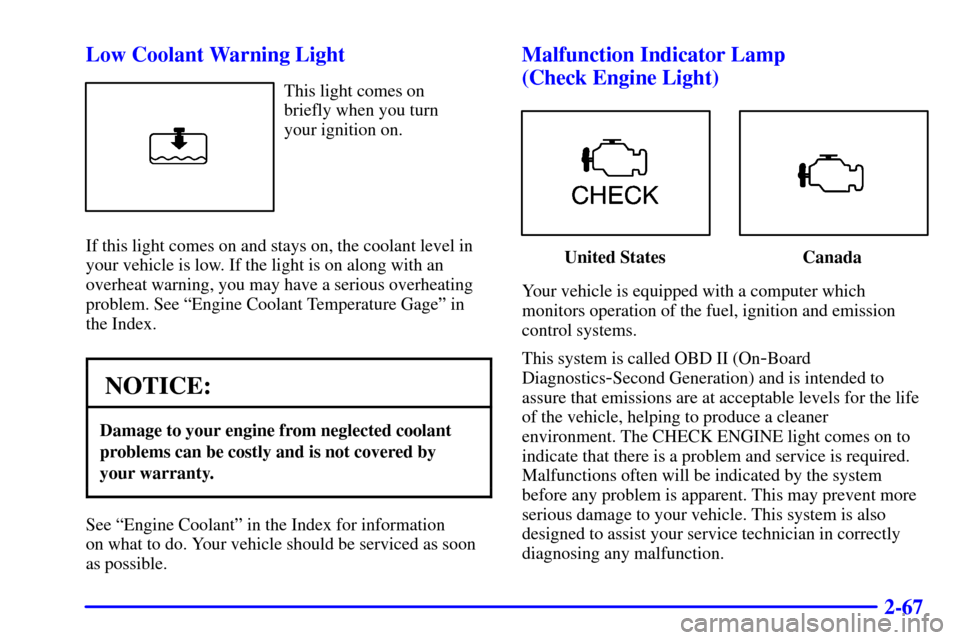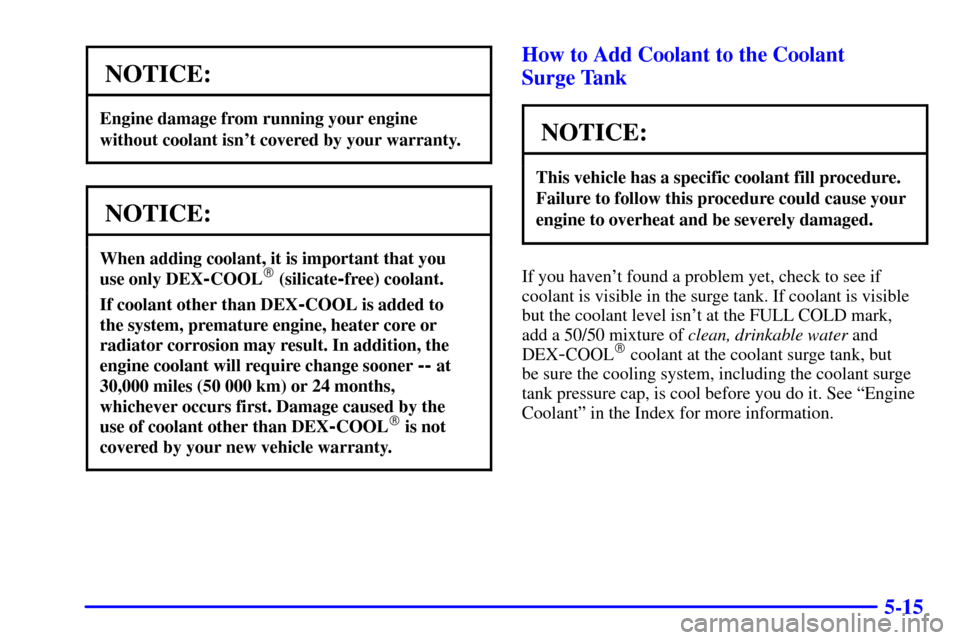Page 128 of 360

2-67 Low Coolant Warning Light
This light comes on
briefly when you turn
your ignition on.
If this light comes on and stays on, the coolant level in
your vehicle is low. If the light is on along with an
overheat warning, you may have a serious overheating
problem. See ªEngine Coolant Temperature Gageº in
the Index.
NOTICE:
Damage to your engine from neglected coolant
problems can be costly and is not covered by
your warranty.
See ªEngine Coolantº in the Index for information
on what to do. Your vehicle should be serviced as soon
as possible.
Malfunction Indicator Lamp
(Check Engine Light)
United States Canada
Your vehicle is equipped with a computer which
monitors operation of the fuel, ignition and emission
control systems.
This system is called OBD II (On
-Board
Diagnostics
-Second Generation) and is intended to
assure that emissions are at acceptable levels for the life
of the vehicle, helping to produce a cleaner
environment. The CHECK ENGINE light comes on to
indicate that there is a problem and service is required.
Malfunctions often will be indicated by the system
before any problem is apparent. This may prevent more
serious damage to your vehicle. This system is also
designed to assist your service technician in correctly
diagnosing any malfunction.
Page 139 of 360

3-4 Air Conditioning
On very hot days, open the windows long enough to
let hot, inside air escape. This reduces the time it takes
for your vehicle to cool down, which should help
fuel economy.
For quick cool
-down on very hot days, use the
maximum mode setting with the temperature knob
all the way in the blue area. If this setting is used for
long periods of time, the air in your vehicle may become
too dry. The best cool
-down happens if you start in
one of the other modes and then switch to maximum.
For normal cooling on hot days, use vent with the
temperature knob in the blue area and the A/C button
pressed in. The system will bring in outside air and cool it.
On cool, but sunny days, the sun may warm your upper
body, but your lower body may not be warm enough.
You can use bi
-level with the temperature knob in the
middle and the A/C button pressed in. The system will
bring in outside air and direct slightly warmer air to
your lower body. You may notice this temperature
difference more at some times than others.
Heating
On cold days, use floor with the temperature knob all
the way in the red area. The system will bring in outside
air, heat it and send it to the floor ducts.
Your vehicle has heat ducts that are directed toward
the rear seat. Keep the area under the front seats clear
of obstructions so the heated air can reach the rear
seat passengers.
If your vehicle has an engine coolant heater, you can use
it to help your system provide warm air faster when it's
cold outside (0�F (
-18�C) or lower). An engine coolant
heater warms the coolant your engine and heating
system use to provide heat. See ªEngine Coolant
Heaterº in the Index.
Defogging and Defrosting
Your system has two settings for clearing the front
and side windows. To defrost the windows quickly,
use defrost with the temperature knob all the way
in the red area. To warm passengers while keeping the
windows clean, use defog.
Page 221 of 360
5-14
If the coolant inside the coolant surge tank is boiling,
don't do anything else until it cools down. The vehicle
should be parked on a level surface.
The coolant level should be
at the FULL COLD mark.
If it isn't, you may have a
leak at the pressure cap or
in the radiator hoses, heater
hoses, radiator, water pump
or somewhere in the
cooling system.
CAUTION:
Heater and radiator hoses, and other engine
parts, can be very hot. Don't touch them.
If you do, you can be burned.
Don't run the engine if there is a leak. If you run
the engine, it could lose all coolant. That could
cause an engine fire, and you could be burned.
Get any leak fixed before you drive the vehicle.
If there seems to be no leak, with the engine on,
check to see if the electric engine cooling fan is running.
If the engine is overheating, the fan should be running.
If it isn't, your vehicle needs service.
Page 222 of 360

5-15
NOTICE:
Engine damage from running your engine
without coolant isn't covered by your warranty.
NOTICE:
When adding coolant, it is important that you
use only DEX
-COOL� (silicate-free) coolant.
If coolant other than DEX-COOL is added to
the system, premature engine, heater core or
radiator corrosion may result. In addition, the
engine coolant will require change sooner
-- at
30,000 miles (50 000 km) or 24 months,
whichever occurs first. Damage caused by the
use of coolant other than DEX
-COOL� is not
covered by your new vehicle warranty.
How to Add Coolant to the Coolant
Surge Tank
NOTICE:
This vehicle has a specific coolant fill procedure.
Failure to follow this procedure could cause your
engine to overheat and be severely damaged.
If you haven't found a problem yet, check to see if
coolant is visible in the surge tank. If coolant is visible
but the coolant level isn't at the FULL COLD mark,
add a 50/50 mixture of clean, drinkable water and
DEX
-COOL� coolant at the coolant surge tank, but
be sure the cooling system, including the coolant surge
tank pressure cap, is cool before you do it. See ªEngine
Coolantº in the Index for more information.
Page 225 of 360
5-18
1. Park the vehicle on a level surface. You can remove
the coolant surge tank pressure cap when the cooling
system, including the coolant surge tank pressure cap
and upper radiator hose, is no longer hot. Turn the
pressure cap slowly counterclockwise (left) about
two or two and one
-half turns. If you hear a hiss,
wait for that to stop. This will allow any pressure
still left to be vented out the discharge hose.
2. Then keep turning the
pressure cap slowly,
and remove it.
Page 226 of 360
5-19
3. Then fill the coolant surge tank with the proper
mixture, to the hash mark on the label. Wait about
five minutes, then check to see if the level is below
the hash mark. If the level is below the hash mark,
add additional coolant to bring the level up to the
hash mark. Repeat this procedure until the level
remains constant at the hash mark for at least
five minutes.
4. With the coolant surge
tank pressure cap off,
start the engine and
let it run until you
can feel the upper
radiator hose getting
hot. Watch out for the
engine cooling fan.
By this time, the coolant level inside the coolant
surge tank may be lower. If the level is lower than
the FULL COLD mark, add more of the proper
mixture to the coolant surge tank until the level
reaches the FULL COLD mark.
Page 240 of 360

6-
6-1
Section 6 Service and Appearance Care
Here you will find information about the care of your vehicle. This section begins with service and fuel information,
and then it shows how to check important fluid and lubricant levels. There is also technical information about your
vehicle, and a part devoted to its appearance care.
6
-2 Service
6
-3 Fuel
6
-5 Fuels in Foreign Countries
6
-6 Filling Your Tank
6
-8 Filling a Portable Fuel Container
6
-9 Checking Things Under the Hood
6
-14 Engine Oil
6
-21 Engine Air Cleaner/Filter
6
-23 Automatic Transaxle Fluid
6
-24 Manual Transaxle Fluid
6
-24 Hydraulic Clutch
6
-25 Engine Coolant
6
-28 Surge Tank Pressure Cap
6
-29 Power Steering Fluid6
-29 Windshield Washer Fluid
6
-31 Brakes
6
-35 Battery
6
-36 Bulb Replacement
6
-43 Tires
6
-51 Appearance Care
6
-52 Cleaning the Inside of Your Vehicle
6
-54 Care of Safety Belts
6
-55 Cleaning the Outside of Your Vehicle
6
-60 Vehicle Identification Number (VIN)
6
-61 Electrical System
6
-66 Replacement Bulbs
6
-66 Capacities and Specifications
6
-67 Normal Maintenance Replacement Parts
Page 266 of 360
6-27 Checking Coolant
The surge tank is located
on the passenger's side of
the engine compartment.
See ªEngine Compartment
Overviewº in the Index
for more information
on location.
CAUTION:
Turning the surge tank pressure cap when the
engine and radiator are hot can allow steam and
scalding liquids to blow out and burn you badly.
Never turn the surge tank pressure cap
-- even a
little
-- when the engine and radiator are hot.
The vehicle must be on a level surface. When your
engine is cold, the coolant level should be at the FULL
COLD mark.
If the low coolant light
comes on and stays on,
it means you're low on
engine coolant.
See ªLow Coolant Lightº in
the Index.